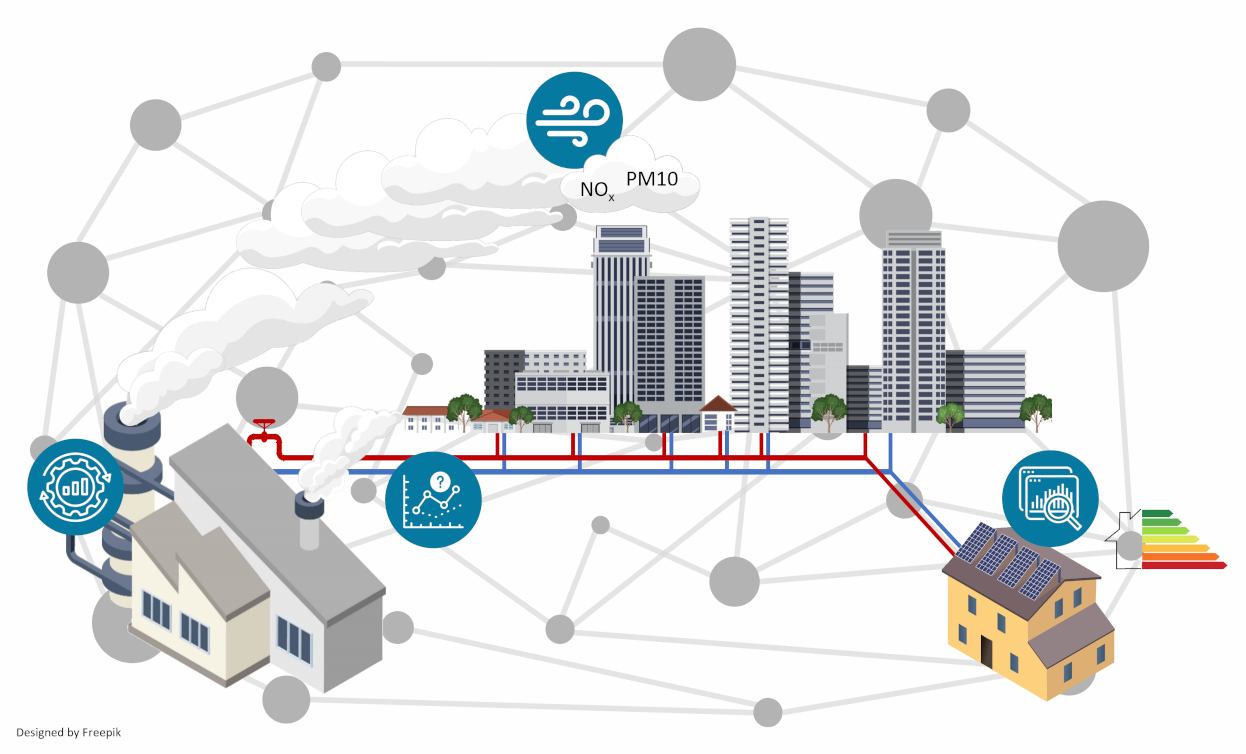Dynamic control of district heating networks with integrated emission modelling: A dynamic knowledge graph approach
- Provide proof-of-concept for knowledge graph-native receding horizon control.
- Connect energy and air quality domain with integrated emission dispersion modelling.
- Embed general forecasting capabilities within a dynamic knowledge graph.
- Develop domain ontologies to represent district heating operations data.
- Showcase capabilities of semantic ecosystem to provide holistic energy perspectives.
 This paper presents a knowledge graph-based approach for the dynamic control of a district heating network with integrated emission dispersion modelling. We propose an interoperable and extensible implementation to forecast the anticipated heat demand of a municipal heating network, minimise associated total generation cost based on a previously devised methodology, and couple it with dispersion simulations for induced airborne pollutants to provide automatic insights into air quality implications of various heat sourcing strategies. We create cross-domain interoperability in the nexus of energy and air quality via newly developed ontologies and semantic software agents, which can be chained together via The World Avatar dynamic knowledge graph to resemble the behaviour of complex systems. Furthermore, we integrate the City Energy Analyst into this ecosystem to provide building-level insights into energy demand and renewable generation potential to foster strategic analyses and scenario planning. Underlying calculations use building and weather data from the knowledge graph in place of inherent assumptions in the official software release, facilitating a more data-driven approach. All use cases are implemented for a mid-size town in Germany as a proof-of-concept, and a unified visualisation interface is provided, allowing for the examination of 3D buildings alongside their corresponding energy demand and supply time series, as well as emission dispersion data. With this work, we outline the potential of Semantic Web technologies to connect digital twins for holistic energy modelling in smart cities, thereby addressing the increasing complexity of interconnected energy systems.
This paper presents a knowledge graph-based approach for the dynamic control of a district heating network with integrated emission dispersion modelling. We propose an interoperable and extensible implementation to forecast the anticipated heat demand of a municipal heating network, minimise associated total generation cost based on a previously devised methodology, and couple it with dispersion simulations for induced airborne pollutants to provide automatic insights into air quality implications of various heat sourcing strategies. We create cross-domain interoperability in the nexus of energy and air quality via newly developed ontologies and semantic software agents, which can be chained together via The World Avatar dynamic knowledge graph to resemble the behaviour of complex systems. Furthermore, we integrate the City Energy Analyst into this ecosystem to provide building-level insights into energy demand and renewable generation potential to foster strategic analyses and scenario planning. Underlying calculations use building and weather data from the knowledge graph in place of inherent assumptions in the official software release, facilitating a more data-driven approach. All use cases are implemented for a mid-size town in Germany as a proof-of-concept, and a unified visualisation interface is provided, allowing for the examination of 3D buildings alongside their corresponding energy demand and supply time series, as well as emission dispersion data. With this work, we outline the potential of Semantic Web technologies to connect digital twins for holistic energy modelling in smart cities, thereby addressing the increasing complexity of interconnected energy systems.
- This paper draws from preprint 319: Dynamic Control of District Heating Networks with Integrated Emission Modelling: A Dynamic Knowledge Graph Approach
- Access the article at the publisher: DOI: 10.1016/j.egyai.2024.100376



